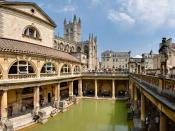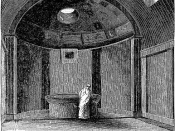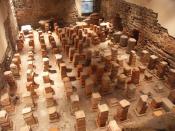Did the Romans only use the baths to get clean or were there political and social motivations behind the number of romans regularly going to the baths?"
INTRODUCTION
The idea of public baths was originally Greek, and the Romans picked up on the idea around the second century B.C.
The first palatial bath (Thermae) was built by Agrippa in the Campus Martius. Others were located near the pantheon in Rome, on the slopes of the Esquiline Hill, near the Colusseum, by Porta Capena and on the Quirinai Hill. These Thermae were not merely baths. Some contained art galleries and halls to hire or use freely to meet friends in, others had large palaestra's (exercise yards) within or nearby.
Before the great Thermae were built, smaller public baths called 'Balnea' were run by individuals trying to make a profit. These were plentiful in Augustus' time, there were about 170 in Rome, but by Pliny's era 'an infinite number' (1) and at the fall of the Empire, well over 900.
Of course, some Balinea had very bad reputations as brothels where men and women were allow to bathe together (2) but these were avoidable for any Roman who knew his city well.
One source (3) says,
'Socially the Baths were an important meeting and mixing place. Everyone had his favourite Baths just as every Englishman has his favourite public house'.
This comparison of the Baths and a modern pub leads to the question my coursework examines:
'Did the Romans only use the Baths to get clean or were there political and social motivations behind the number of Roman's regularly going to the Baths?'
It will do so first by examining the purpose of the baths for the Romans and their nature. Second, it will look at a case study on...



Common feature
So, what are the common feature amoung roman baths?
2 out of 3 people found this comment useful.